Kuwait Petroleum Company and its subsidiaries lead a broad, multifaceted hydrocarbons industry in Kuwait. KOC manages all upstream development on Kuwait territory, except for the Divided Zone, and represents the country in the World Bank-led Global Gas Flaring Reduction Partnership (GGFR).
Effective gas management is a key objective for the company, to optimize the utilization of this valuable resource and reduce its environmental impact. The mission is to reduce gas flaring less than 1% of total production by 2017. To achieve this target, KOC conducted thorough, periodic reviews of the gas value chain from producing well to end user in order to identify all sources of waste or potential optimization. Results are monitored at the highest management levels. All the staff is involved and committed to this objective, which stands high on their Key Performance Indicators list.
“We are strongly committed to creating a healthier environment, and have dramatically reduced gas flaring. We are steadfast to further reduce it to as low as possible,” said KOC’s Manager Gas Operations Group, Mohammed Al-Zuabi. “I firmly believe it was only possible because there was a complete change in the employee mindset towards better understanding the environmental consequences of gas flaring and preserving a very valuable resource,” he added.
KOC’s successful gas flaring reduction is a result of several key factors:
- a solid commitment from all levels of the company to make flare reduction a priority;
- significant financial investments in state-of-the-art facilities and operations;
- close cooperation within KOC departments and with downstream companies and customers in order to adapt to any unforeseen situations and limit the duration of flaring; and
- a close, productive partnership with GGFR and other organizations to achieve the target.
KOC is still actively engaged in gas flaring reduction projects, striving to achieve a “Lowest Technical Limit” objective, and working with GGFR on this objective. Top management at the company constitutes a task force team to continue looking for solutions and develop a roadmap and flare reduction action plan.

